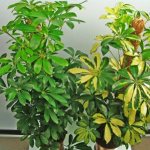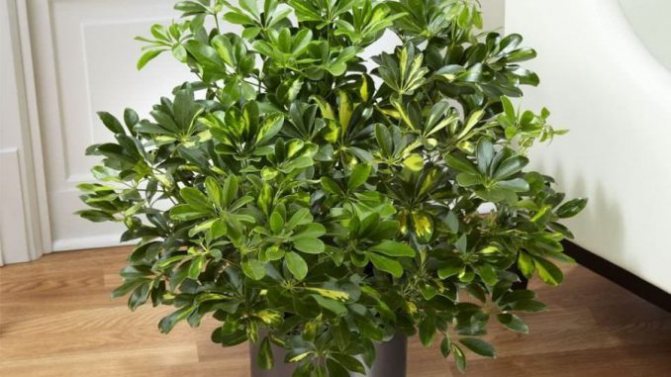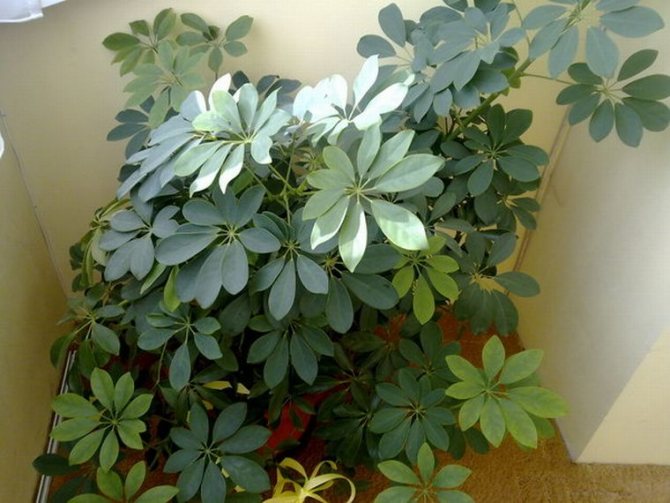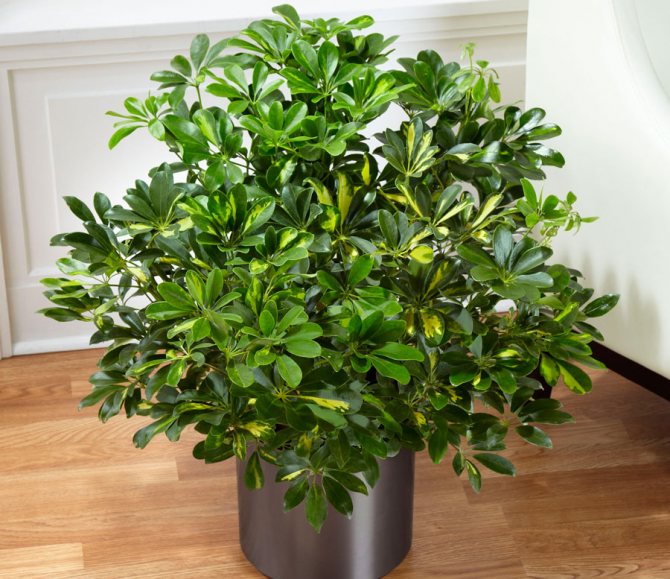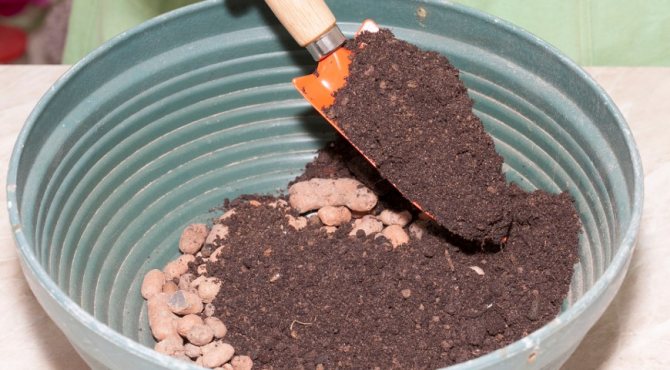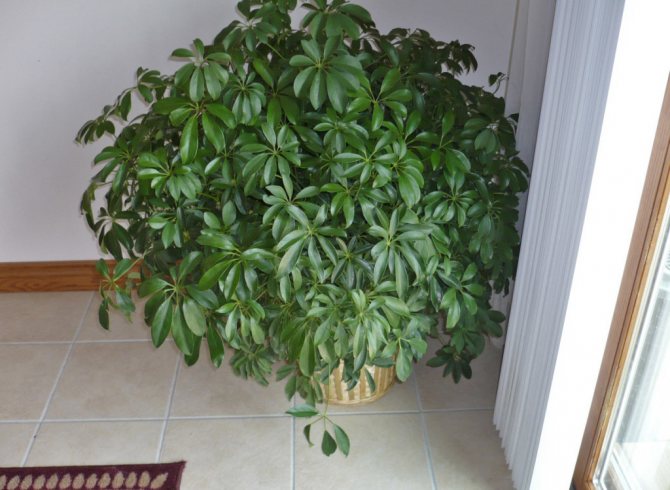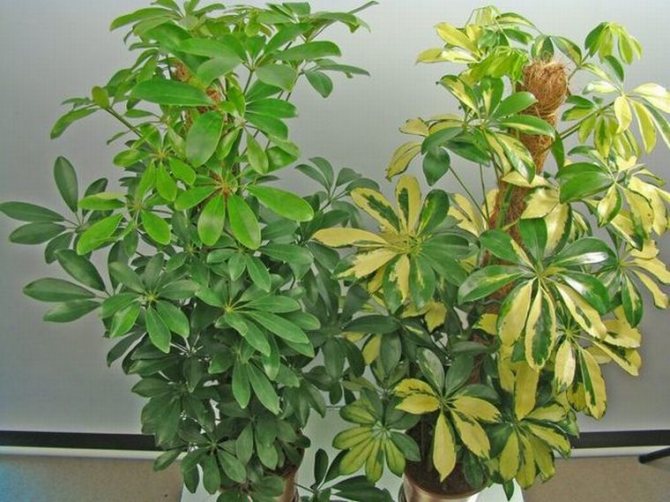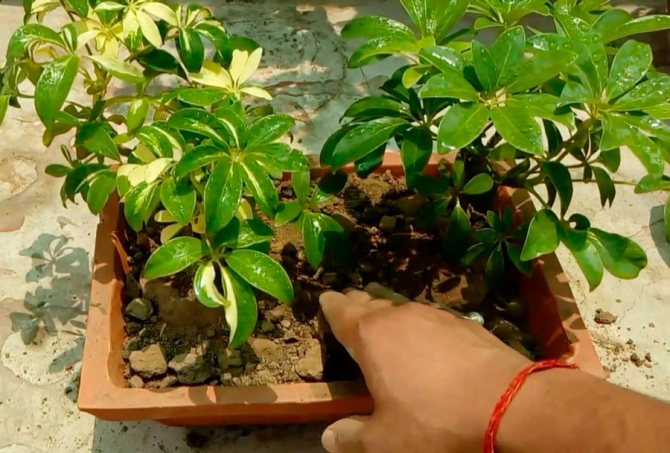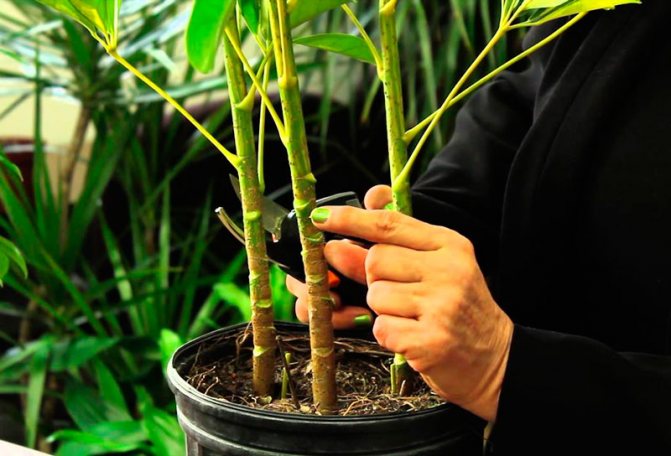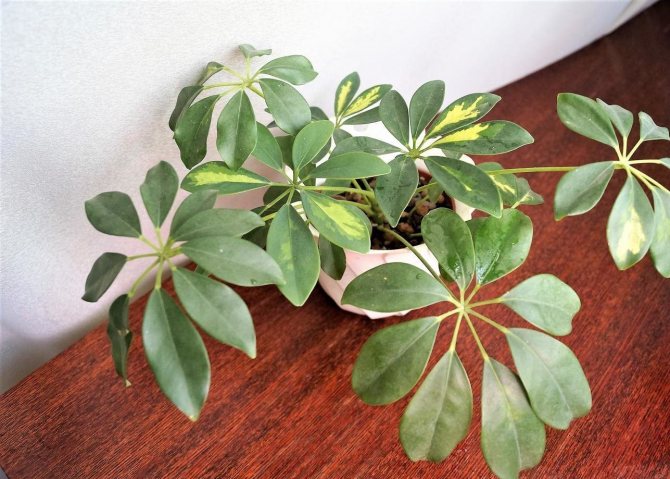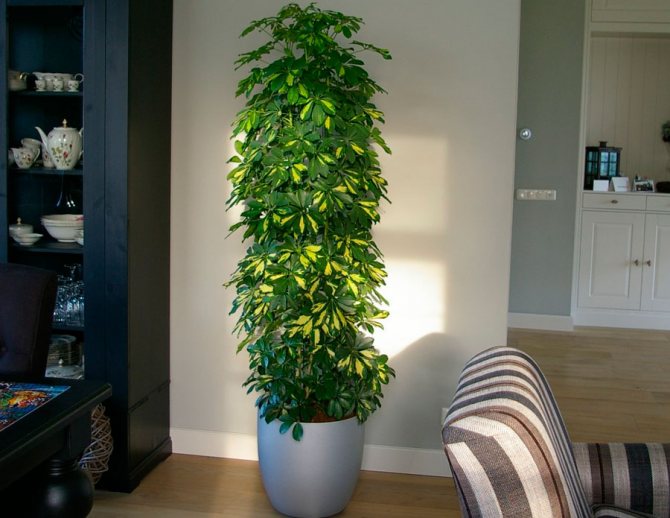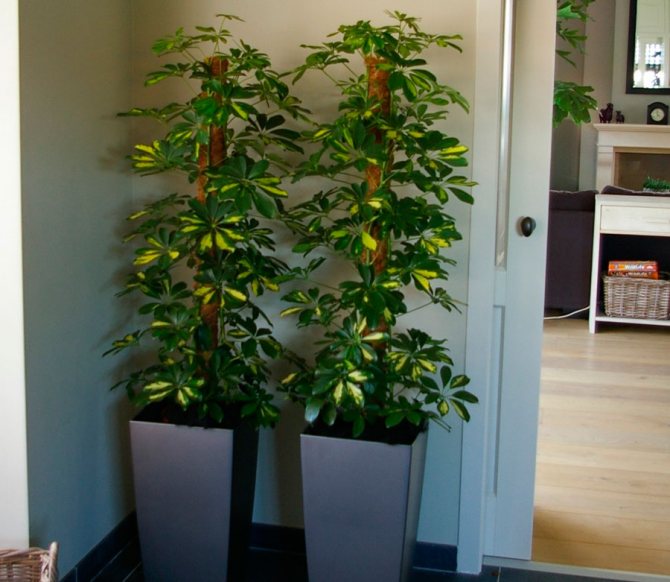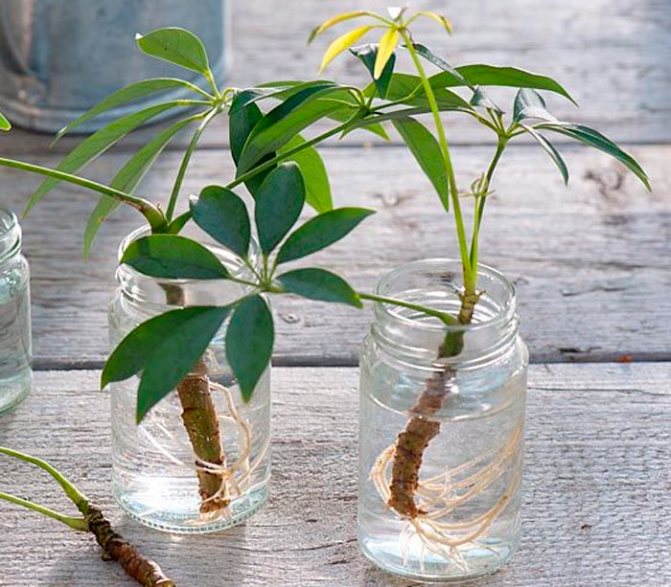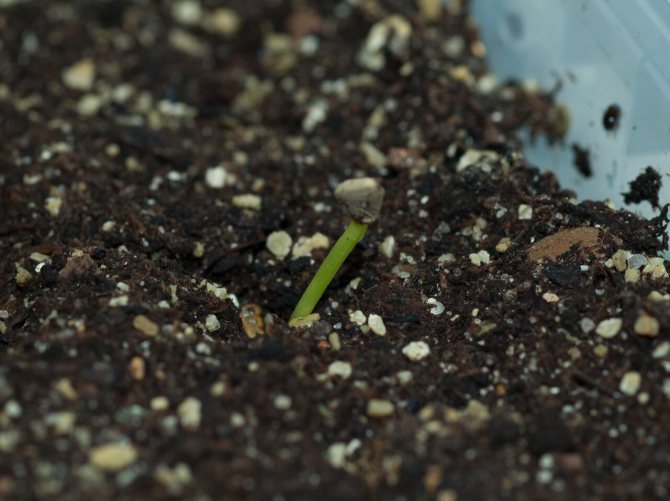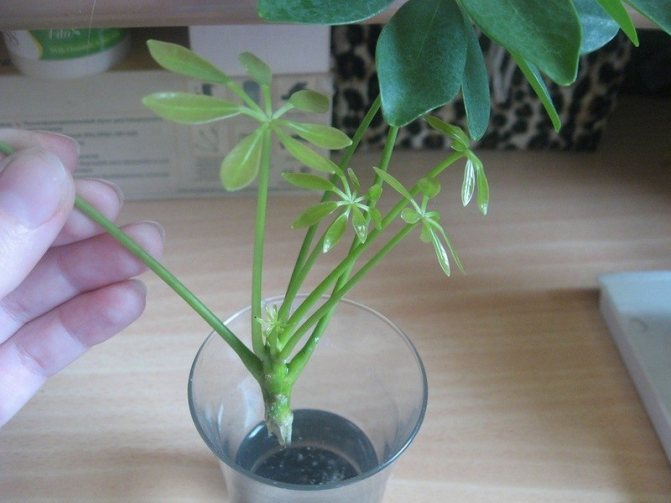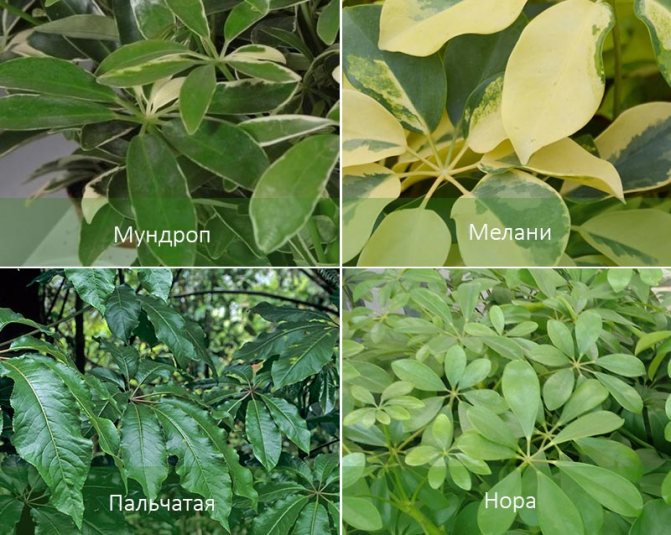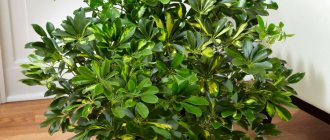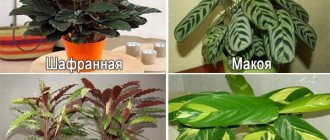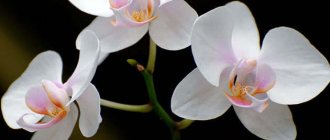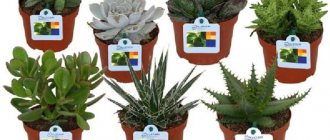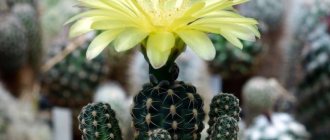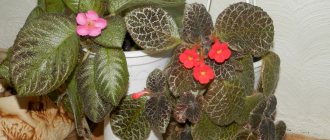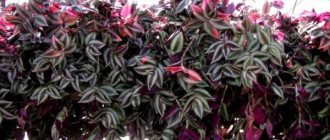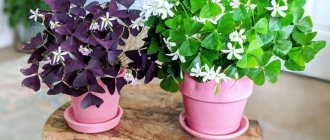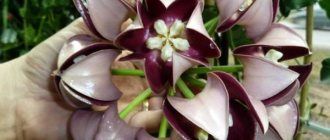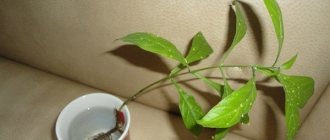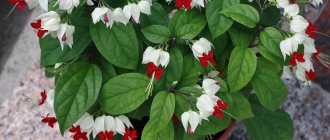The Scheffler plant is named after the German botanist Scheffler and belongs to the Araliev family. Ginseng and ivy are also members of this family. Schefflera plant of the tropics and subtropics, at home it is considered quite aggressive, displacing other cultures. But the shefler's flower is very beautiful.
It has become a popular houseplant in our country and is recognized by its complex finger-like leaves.
There can be from 5 to 18 of them.
The leaf plate itself, depending on the type, can be narrow, rounded, serrated and wavy.
Observed a wide variety of shapes, which are united under one name. There are several hundred types of it.
Content
- General information
- Schefflera species and varieties
- Schefflera home care
- Watering shefflers
- Soil for shefflers
- Sheffler pot
- Sheffler transplant
- Fertilizer for shefflers
- Flowering shefflers
- Scheffler pruning and shaping
- Scheffler in winter
- Propagation of shefflers by cuttings
- Scheffler from seed at home
- Reproduction of shefflers by air layers
- Scheffler leaf propagation
- Sheffler diseases and pests
Care
Almost all Scheffler species need the same conditions of detention, with the exception of the differences described in this article. General recommendations for care, breeding methods and other interesting facts can be found in the corresponding article.
Related entries:
- Caring for the Shefflera (umbrella tree) and breeding it at home The tall shrub with remarkable leaves turned out to be an unexpected drinker. Contents1 Description of the plant2 Lighting3 Watering4 Reproduction5 Transfer and handling6 Crohn7 Diseases8 ...
- Eucalyptus. Leaves are a whole home medicine cabinet with a set of medicinal properties. Recently, this tree has attracted the attention of not only koalas, but also indoor florists. Content1 Description of the plant2 Species3 Growing3.1 From ...
General information
There are more than 200 varieties in the Sheffler genus. Not all representatives of the sheffler are suitable for growing at home, since many of them in nature can grow up to 40 meters. Houseplants are much smaller, but with good care they can easily grow to the ceiling.
The flower tolerates shaping pruning well, so the grower can give his plant absolutely any shape. Caring for a shefflera is quite simple, so even novice growers can cope with this unusual plant, growing a beautiful specimen to the envy of everyone.
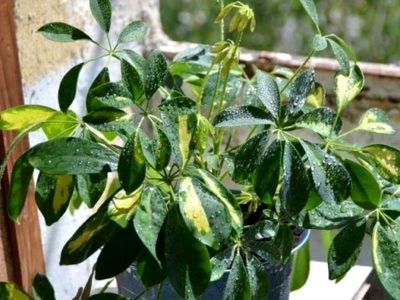
Folk beliefs
There are many signs and superstitions associated with the plant. Here is some of them:
- The flower absorbs negative energy, thereby normalizing the indoor environment. Therefore, it is important for the sheffler to put it in those places (houses, hospitals, offices, etc.) where people often quarrel, quarrel and cannot find a common language with each other.
- If, at the end of a hard day's work, you sit down for a short time near a flower, you can get rid of fatigue and headaches.
- Scheffler improves the indoor climate by saturating it with oxygen and humidifying the air. Therefore, if you put it in the bedroom, you can get rid of insomnia in a matter of days.
- Bioenergy therapists recommend the plant to young families or couples in love, as it harmonizes relationships and prevents minor conflicts.
- If you put a flower in a nursery, your child's mental abilities will soon increase and his school performance will improve.
- If the shefflera is growing rapidly and luxuriantly, the family may soon be expected to replenish or increase income.
- If the leaves have darkened sharply or dried out, this indicates negative energy in the house.
Important! Astrologers recommend the plant to the fire signs of the zodiac (Aries, Leo and Sagittarius).
Schefflera species and varieties
Schefflera Gold Capella - is a cultivated form of a tree-like sheffler, grown as a house plant. Shefflers of this species are native to Southeast Asia. The plant is a small tree with a straight trunk that resembles a palm tree. The height of the flower reaches 120 centimeters. It has lush, bright green foliage with golden spots.
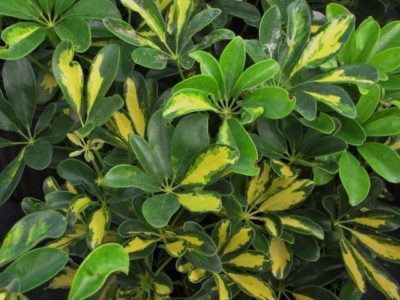

Schefflera Nora - is an indoor plant variety, which is distinguished by an elegant foliage and unpretentious care. The flower has long and narrow leaf plates of a green hue with bright yellow dots. The edges of the leaves are decorated with even teeth. Schefflera has a lush crown and dense foliage.
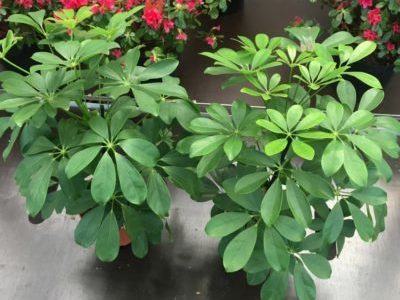

Schefflera Janine - has all the advantages of its kind and is just as unpretentious in care as other shefflers. Among others, it is distinguished by elegant, variegated foliage. Dark green leaf plates are diluted with light specks and streaks. Janine normally treats the shade and does not lose the variegation of the color of its leaves.
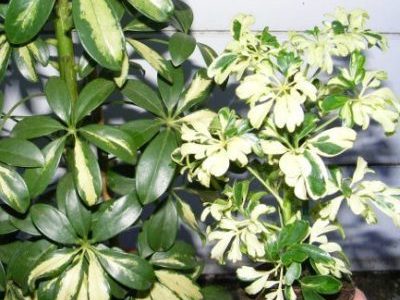

Scheffler Gerd - is easy to clean. The plant will be comfortable on a windowsill with diffused lighting. It reaches a height of 50 centimeters to 2.5 meters. He needs a moist and fertile soil. The leaf plates of the plant are variegated, having a pale green or yellow-green color.
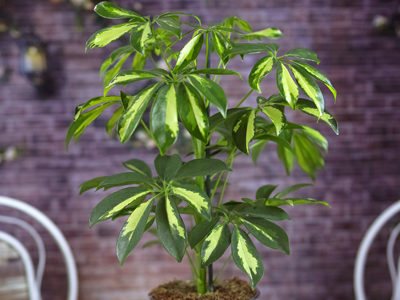

Scheffler Louisiana - the most graceful representative of her kind. It has openwork, leathery, shiny leaf plates that have an unusual decorative effect and a motley green-yellow tint.
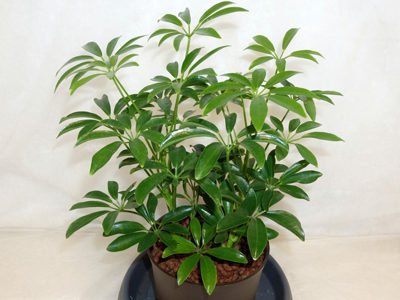

Schefflera Bianca
This variety differs from the rest in shorter leaves, which reach up to 8 centimeters in length. Each leaf plate has a white edging and beige blotches at the base. Due to the contrast of dark and light shades, decorative notches decorating the edges of the leaves become almost invisible.
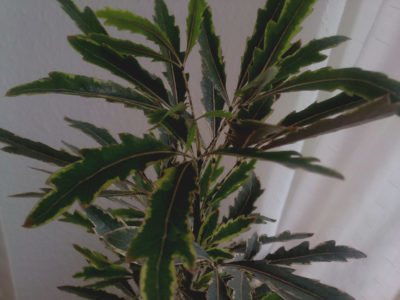

Schefflera tree (Scheffler arboricola) - is a flowering shrub, the homeland of which is considered to be China. In nature, it has a straight trunk and reaches a height of up to 4 meters. The plant has complex, palmate, large leaf plates of a light green hue.
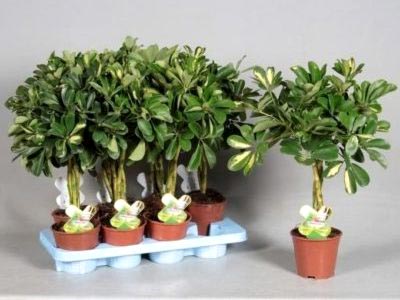

Schefflera Caster - the plant has decorative dimensions, so it will be ideal for growing in an apartment. It reaches a height of up to 120 centimeters and has medium-sized, dark green, leathery, shiny leaf plates.
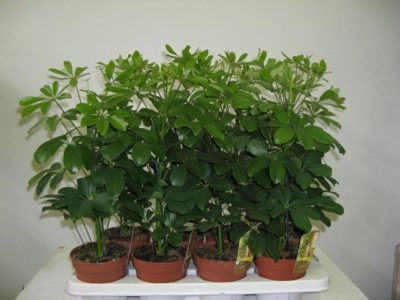

Schefflera Radiant (Schefflera star-leaved) - is the most common type of plant. In nature, the sheffler reaches a height of 15 meters and can have one or two trunks. When growing a tree at home, it will grow up to 2.5 meters in height. It has dark green, leathery, shiny, large, jagged leaf plates. Shefflera blooms with small red inflorescences.
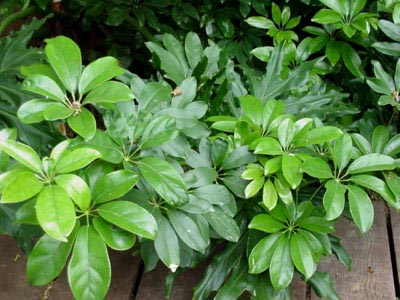

Schefflera Mundrop
It is one of the smallest species. It is home to Asia, China and Australia. The plant has several trunks, on which are palm-compound leaves with a green color and yellowish or white spots.
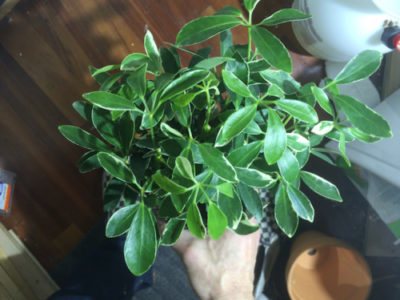

Schefflera Amate - the plant can grow up to 2.5 meters in length and has shiny, large, feathery, waxy leaf plates of a dark green hue. The flower is resistant to pests and tolerates shade well, therefore it is suitable for apartments with windows facing north.
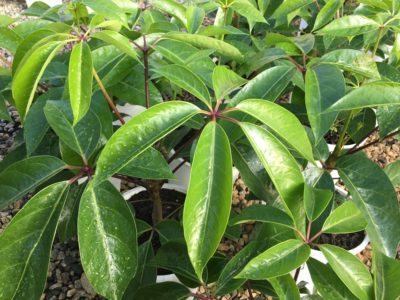

Sheffler Melanie - belongs to the genus treelike sheffler. It can reach a height of up to 1.5 meters. It has a lush crown with olive, shiny, large leaf plates with dark green stains. The plant is unpretentious in care, therefore it is suitable for beginner flower growers.
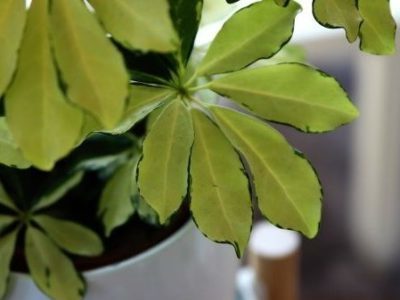

Schefflera Variegated - this plant grows up to 1.5 meters in length and has dark green feathery leaf plates with olive streaks and intersperses. It is unpretentious to care for and is practically not susceptible to pest attacks.
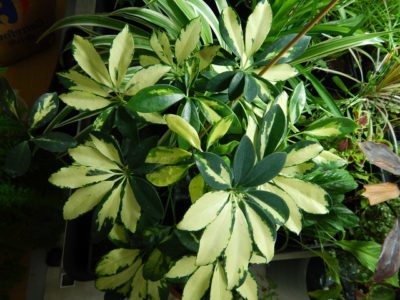

Schefflera spotted
The plant of this variety is distinguished by its unusual decorative leaves, which are large in size and a dark green shade with yellow spots and serrations along the edges. The flower is easy to care for and is suitable for growing in apartments and offices.
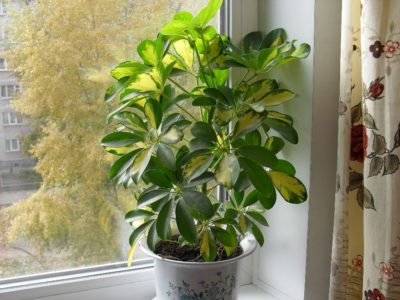

Scheffler Charlotte - this species was bred relatively recently. The plant has unusual leaf plates, the outer part of which has a light shade, the edges are decorated with a dark green edging, and the reverse side of the leaf plates has a rich dark green hue. The plant resembles a palm tree, is easy to care for and has high decorative qualities.
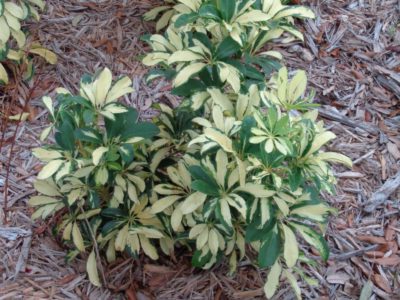

Scheffler's eight-leafed - This plant species grows in the wild in China, India and Japan. The height of the tree reaches up to 2 meters. Its leaves are covered with small, light-colored needles that fall off over time. Each leaf has eight large oval shaped green leaf plates.
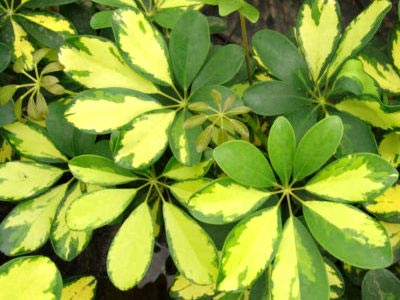

Scheffler's finger - the birthplace of the plant is New Zealand. In nature, it grows in tropical forests, where it reaches a height of 8 meters. Its leaf plate is divided into 7 parts, which resemble the fingers of a human hand. The leaves have pointed edges and a dark green tint.
The inflorescences of this sheffler variety have a paniculate shape. They are quite large and reach a diameter of up to 40 centimeters. After the plant fades, fruits appear in place of the flowers, which are eaten by tropical birds. Schefflera is listed in the Red Book, as local residents sell young shrubs to tourists, thereby reducing its number.
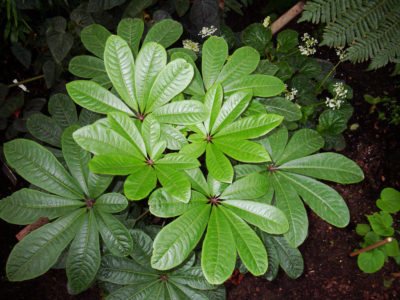

Scheffler plant characteristic
Belongs to the Araliev family. It is a tree, a shrub that can grow up to 10 meters in tropical forests. In an apartment, the plant is much more compact: it usually reaches a height of 0.5-2.5 meters. Schefflera has long won the hearts of domestic florists. It is grown in many homes. The culture brings a touch of the equatorial tropics to the ordinary interior. This picturesque plant is distinguished by an abundance of bright foliage. She is finger-dissected. One sheet consists of 4-12 parts. It is very similar to an umbrella full of holes or a palm with outstretched fingers. The surface is bright. White or creamy yellow blotches are present.
Shoots are thin and long. Schefflera blooms with light inconspicuous flowers, which are collected in panicles. After the end of the flowering phase, clusters of small berries are formed. However, the palm tree rarely blooms indoors. Read an article about the causes of yellowed leaves in zamiokulkas.
Schefflera home care
Schefflera is very light-requiring. At the end of autumn, the plant should be moved to a windowsill facing the south side of the house. There it should be until spring. In summer, the plant needs shading so that direct sunlight does not fall on it.
If there is little light in the apartment or house, then it is better to choose those varieties of shefflers that tolerate shade well and have green foliage. Variegated varieties in this case are not suitable, since they require a lot of light to preserve decorativeness. In the summer, the plant must be taken out into the street, placing it in a shaded area.
Sheffler will be comfortable if the grower in the room provides her with high humidity, although she can adapt to normal humidity. The plant needs regular sprinkling, which is carried out with warm, settled water.
The tree will grow and thrive well at room temperature. In the winter season, temperature indicators should not drop below + 12 degrees. There should be no drafts in the room with the shefflera, nor should it be placed next to the battery. However, small temperature drops will benefit the plant.
Heptapleurum is also a member of the Araliev family. It is grown when nursing at home without much hassle, if you follow the rules of agricultural technology. All the necessary recommendations can be found in this article.
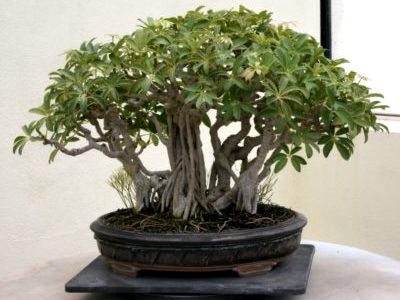

Sheflera
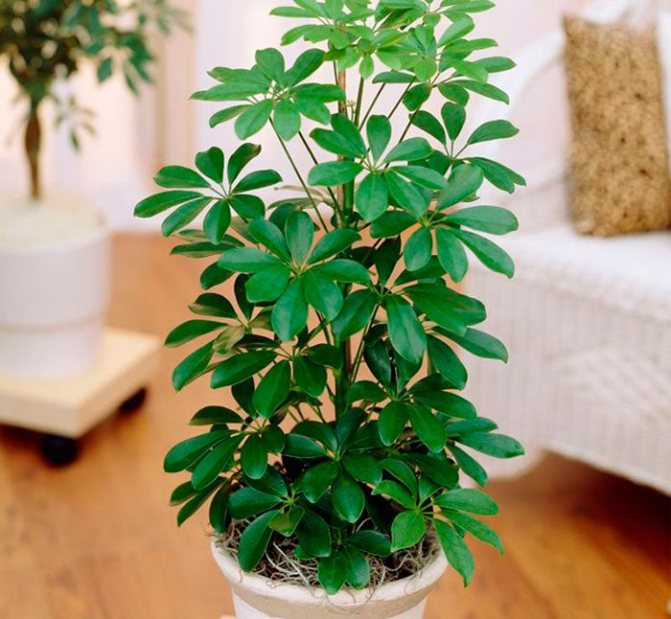

A plant like cheflera or shefflera (Schefflera) belongs to the family called Araliaceae. In the wild, it can be found in the tropics in any part of the earth. And most often it is found in Australia, China, the Pacific Islands and Japan. The wild-growing shefflera is not very large trees or bushes.
This plant is very much appreciated by flower growers for beautiful, showy leaves, which are very similar to a human palm, whose fingers are spaced far apart. The leaf blades are placed on a high petiole and are dissected into 4–12 lobes that grow from the 1st point. In some countries, this flower is called the umbrella of the gnomes or the umbrella tree.
The elongated racemose inflorescences of this plant are very similar to tentacles or antennae. But you can look at them only in the botanical garden, and all due to the fact that the sheffler does not bloom in indoor conditions. But she is able to decorate any room thanks to her graceful shape and spectacular foliage.
This flower is very often grown as a ficus benjamin, or rather, it is grown as a large domestic tapeworm plant, forming it in the form of a bush having a sufficiently large size or a tree.
The tall shoots of such a plant are not very thick, which is why often several young shefflers are planted in one pot at once. And then they form a common stem (intertwined). If only one tall flower is planted in the pot, then a support is usually made for it.
This plant is easy enough to grow indoors, and this is because it is completely undemanding and unpretentious. You need to take care of it in almost the same way as for other common house plants.
Note! The chefler contains substances that, once on the mucous membrane or skin, can cause irritation. Therefore, in any manipulation with it, you need to be careful.
Watering shefflers
The tree should be watered systematically, not overwetting the soil too much. Standing water at room temperature is best suited for watering. Care must be taken to ensure that the ground does not dry out.
In winter, when the plant has a dormant period, watering should be reduced. It is impossible to allow waterlogging of the mixture to the ground, its acidification and stagnation of water, otherwise the sheffler will die.
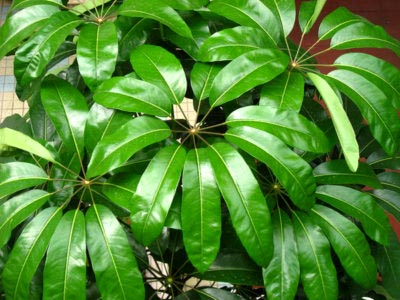

Plant propagation recommendations
The optimum temperature for the cheflera will be 20 ° C, and in winter 12 ° C is permissible. This is a light-loving plant, so it must be carefully protected from drafts and cold by placing the flower on the lightest side of the window sill. The color will tell you about the lack of salt licks: if a bright variegated color suddenly turns green, you need to move the flowerpot to another place, otherwise the plant will begin to shed its leaves and wither. However, in hot summer weather, you need to protect the chefler from direct sunlight, which can cause burns on the leaves.
Do not water the plant too much.If the soil is still damp, no more water is needed, but the soil should not be dry. You can revive such a flower by immersing a container with earth for 15 minutes in warm water.
Usually dry dressings are not used to care for the sheflera. To nourish the plant, only liquid fertilizers are used once every 2 weeks in the summer and once every 2 months in the winter. In addition, the flowerpot must sometimes be sprayed from a spray bottle (water should be at room temperature). If there are several other plant species next to the sheflera, this procedure will not be necessary, since other seedlings will release a sufficient amount of moisture.
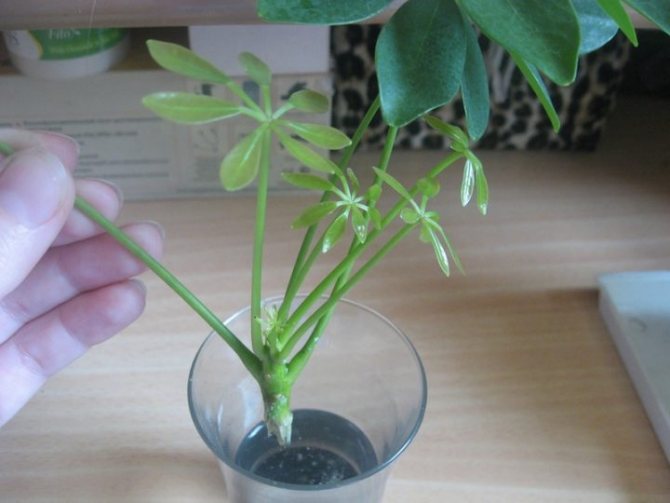

Schefflera in the water
For the first time, the flower is transplanted immediately after reproduction, and then as needed. How to determine this moment? Once every few years, a plant with a clod of earth should be taken out and the root system should be examined. If it densely encircles the soil, the chefler needs to replant.
Each new pot or plant box should be several centimeters larger than the previous one. The transplant can be done in several ways. Usually, the plant is simply transferred from one pot to a larger one. The transshipment method involves the transplantation of chefs without an earthen coma: drainage is laid at the bottom of the container, a plant and a new layer of earth are placed on top.
Soil for shefflers
The soil for the plant should be nutritious and light, only in such a substrate will it feel comfortable.
The mixture can be prepared on your own or you can buy ready-made land in the store, giving preference to the soil for growing ficuses. To prepare the soil at home, you need to take sod, humus and river sand in a 2: 1: 1 ratio.
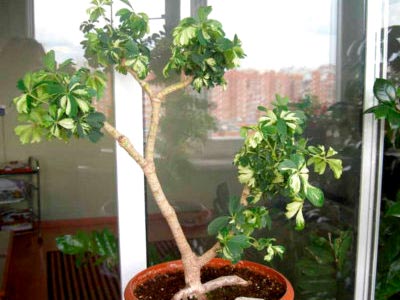

Reproduction
Sheffler is propagated mainly in the spring, in March-April. It is undesirable to propagate it in summer, when it is too hot and in winter, when there is not enough heat and light. There are several types of breeding:
- For propagation by cuttings, you need to cut off semi-lignified shoots. Then cut them so that each has 2 sheets. Cut them in half, dip the cutting in Kornevin and plant in slightly damp ground. Cover with a bag until roots appear, ventilate 2 times a day.
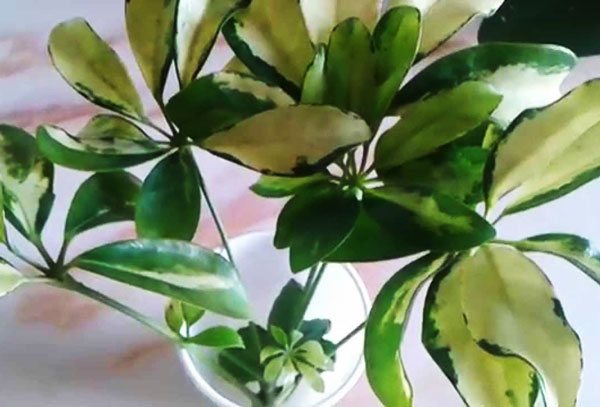

- Since the sheffler does not bloom at home, seeds are bought in specialized stores... They are planted in a 1: 1 mixture of earth and sand, moistened and covered with a lid or bag. For germination, seeds need a temperature of about 25 °. When the second leaf appears, the plant can be transplanted into cups.
- Reproduction in this way is based on the possibility of the formation of aerial roots. Choose any shoot and make an incision... The bark is slightly removed and wrapped with moistened moss, and then polyethylene is fixed on top. The result is a comfortable environment for the formation of new roots.
More details on how to propagate a sheffler by cuttings can be found here:
Sheffler pot
Having prepared the soil mixture, you should choose the right pot for the plant. Everything here will depend on the age of the plant. For example, small pots or even plastic cups are suitable for seedlings.
But, when the roots grow, they should be transferred together with a lump of earth into pots with a diameter of 9 centimeters, and in the fall they should be transplanted into pots 12 centimeters in diameter. With each subsequent transplant, the diameter of the pot must be increased by 3-5 centimeters.
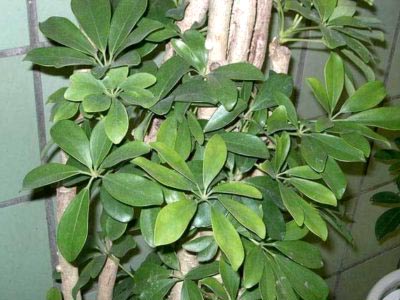

Sheffler transplant
A young tree should be replanted in the first year of its life. This is extremely important for proper growth and development in the future. Before transplanting, you should choose a pot that is suitable in size and prepare the soil.
Then on the bottom of the pot it is necessary to put a drainage layer of gravel or expanded clay. A layer of soil should be poured on top of the drainage and the root system of the plant should be placed on it, slightly shaking it off the ground.After that, gently fill the remaining space in the pot with earth with the mixture and tamp lightly to eliminate the void formed in the pot. After transplanting, the sheffler needs to be watered abundantly.
A mature tree should be replanted every five years. If the plant is very large, then the transplant is carried out very carefully, by moving the shefflers into a new pot along with an earthen lump.
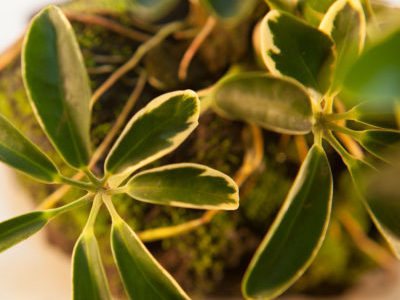

Care difficulties
- The plant sheds leaves - low or too high temperature conditions, drafts are also possible.
- The edges of the leaf plate turn black - the plants are exposed to drafts, dry earthen lump. Choose a cozier spot and keep an eye on your watering schedule.
- White spots on the surface of the leaves - burns, too much sunlight.
- The dull color of the leaves and the elongated shape - the sheffler lacks lighting. Change location and add ambient light.
- Rotting of the root system - excess moisture, too intense watering. This often happens when kept at low temperatures, or there is no drainage system.
- The tips of the leaves dry out, the color fades - low air humidity, high temperature, possibly insufficient spraying, or insufficient watering.
Fertilizer for shefflers
In order for the plant to grow beautiful and healthy, it must be fertilized. Top dressing is carried out with liquid fertilizers for indoor flowers. The frequency of fertilization will depend on the season. During the dormant period from late autumn to early spring, the plant is fertilized once a month, the rest of the time - once every 15–20 days.
The concentration of ready-made dressings may not always meet the needs of the plant. For this reason, experienced flower growers recommend playing it safe by diluting the fertilizer in a lower concentration and fertilizing the tree twice as often. Dry fertilizers for shefflers are not suitable.
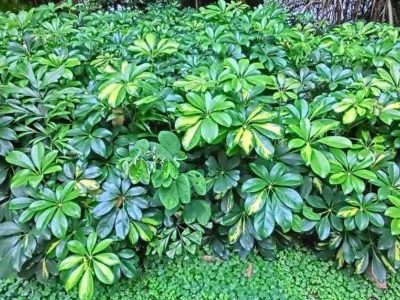

Scheffler pruning and shaping
Flower pruning is carried out in order to form a lush crown and reduce the vertical size in fast-growing plant varieties. The first pruning should be done when the young plant is slightly older. For this purpose, it is necessary to shorten the apical branches by 4 internodes. It is best to cut branches with a sharp pruner. Sections must be treated with activated carbon.
After the lateral branches have grown, you can begin to form a spherical crown, cutting off the tops of the branches. Cuttings obtained during pruning can be used for propagation. It should be noted that pruning greatly weakens the sheffler, so it must be carried out in several stages.
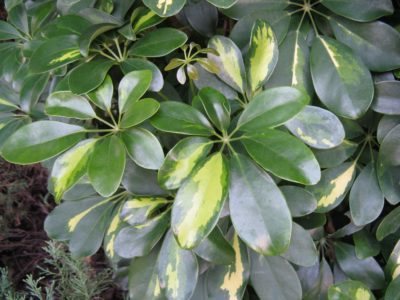

How to properly trim and shape the crown
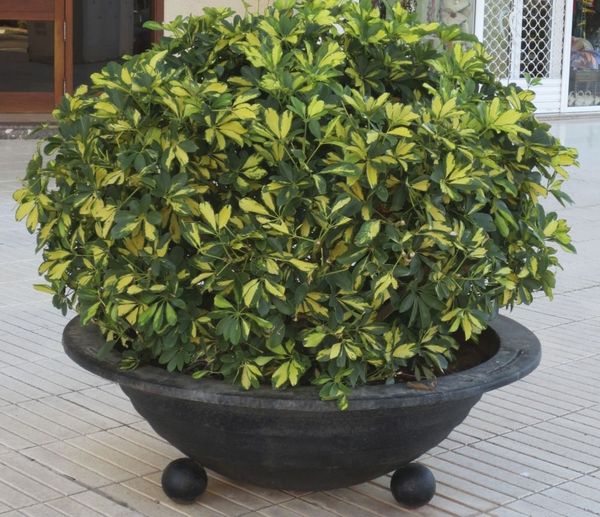

A lush crown can be obtained by pruning
Pruning is an important step in caring for indoor flowers. In order to get a lush plant, form a beautiful crown, Shefler need to be constantly trimmed... If you cut off the top, then the plant will release side shoots and become lush. And the top can be rooted in a glass of water and planted as a separate new plant.
It is allowed to trim for formation, at the discretion of each grower, and side shoots and lower.
If new young shoots are to be obtained, the entire plant should be pruned.
Scheffler in winter
The dormant period for the plant begins at the end of autumn and lasts until spring. At this time, all processes of the sheffler slow down and it stops growing. Accordingly, the care of her is changing.
During this period, it is better to transfer the tree to a bright room with a temperature of at least + 12 degrees. Watering and sprinkling should be minimized, as well as top dressing.
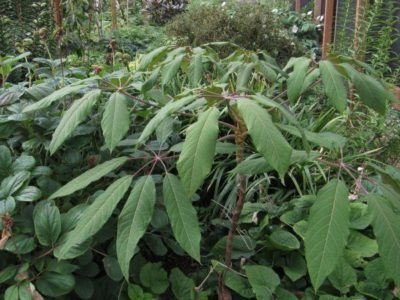

Temperature
Temperature conditions are very important for shefflers. The most comfortable for her will be 15-20o, in winter you need to make sure that the temperature did not drop below 12 degrees, the limit is 10 °. Otherwise, the roots begin to rot.
You won't notice this right away, but over time, the process will spread to the ground part of the plant.When rotting, the stem becomes soft, the leaves may turn black.
Watering
Watering should be moderate. The soil should not be too damp, but only moist. The temperature and quality of the water is of great importance. It is better if the container with water will settle next to the pot.
Caution! Watering with cold water promotes root rot.
Fertilizer
The plant is fertilized from March-April to October-November, that is, during the period of active growth. In winter, the plant needs to rest. It is best not to reinvent the wheel, but to feed it with mineral fertilizer 2 times a month or once every two weeks.
Transfer
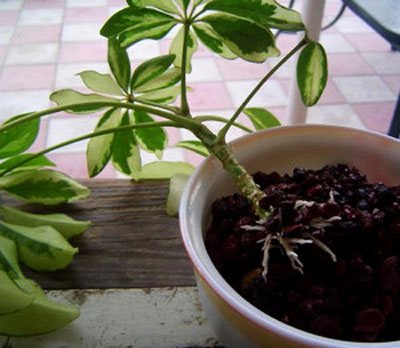

They are transplanted to the sheffler as the container is filled with roots.
You can find out by taking out a wetted clod of earth with roots.
There is another option: watch an adult plant, when the roots are entwined with a ball, the earth dries out faster than usual.
You need to transplant into a large pot. Moisten the ground a little, transplant, being careful not to damage the roots, then fill up the soil. When transplanting, you can use Kornevin.
Sheflera in winter
Shefflera must rest in winter... So that she does not stretch, create comfortable conditions for her. Temperature 14-16 degrees, moderate watering, bright enough lighting and no additional fertilizing.
Attention! Despite the fact that she loves spraying, it is enough to spray the plant 1-2 times a week in winter.
Propagation of shefflers by cuttings
For grafting, shoots are selected from which the stems are already partially stiff and cut off. Then they are treated with drugs that stimulate the growth of the root system. After processing, the cuttings are placed in a mixture of peat and sand.
In order for the planting material to take root, the temperature in the room where it is located should not be lower than + 22 degrees. When the shoots take root, the temperature regime is changed, reducing it to +18 degrees.
After the root system has grown enough, gets stronger and takes up the entire pot, young plants can be transplanted. You can also germinate the root system on cuttings using water. For this purpose, the shoots are placed in cups of warm water and wait until they take root.
After the root system is sufficiently developed to be planted in the ground, the plants are transplanted into separate pots for permanent cultivation.
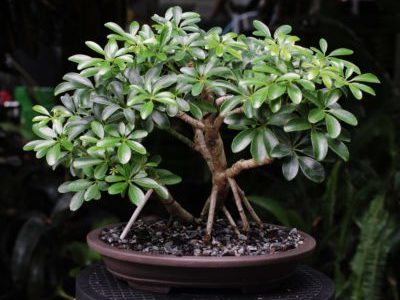

Can the plant be kept at home?
Despite some negative properties of the plant, the sheffler should still be kept in the house, since there are much more advantages. This is the improvement of the financial sphere, and the harmonization of relations between partners and loved ones, and the elimination of insomnia, and the normalization of the mental state, etc. And the beauty of the forms will never interfere, but will only improve the visual background in the room. In addition, the flower perfectly cleans the air.
Note! Sheffler should not start calm and balanced people with a stable psyche (since the plant needs negative energy, and in the absence of such a flower will "pull" health and strength from the owner).
Scheffler from seed at home
The procedure should be started in the second half of winter. Seed material is placed in peat to a depth of 3 to 5 centimeters. After planting, the soil must be watered, covered with foil and the temperature must be from + 22 to + 24 degrees.
From time to time, the film must be removed by airing and spraying crops. When the first leaves begin to appear, the sprouts are transplanted into separate cups and left in the room at 19-20 degrees.
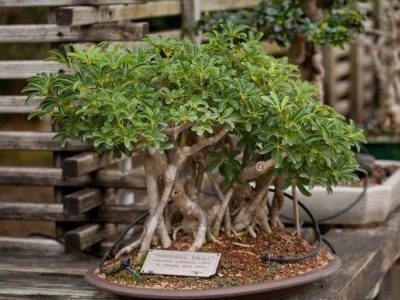

What changes in flower care in winter
As with other indoor plants, Sheflera should be provided with optimal care in the winter. Consider what it consists of and how to care:
- It is necessary to provide more illuminated place... If there is not enough light, additional lighting should be made using lamps.
- The optimal temperature will be 15 degrees, you can not allow a decrease below 12.
- It is not advised to put a houseplant next to heating pipes, it loves high humidity.
- If the temperature in winter is more than 20 degrees, it is worth spraying it regularly.
- Watering should be significantly reduced.
- It is not recommended to feed the soil.
- Transplanting an indoor flower during the winter dormancy is not allowed
Reproduction of shefflers by air layers
To use this method of reproduction, a small incision is made in the outer layer of the trunk, the resulting scar is covered with moist sphagnum, which should be constantly moistened. Then the barrel is wrapped in polyethylene.
After two months, roots appear at the site of the incision. The cut is neatly cut and transplanted into a separate pot.
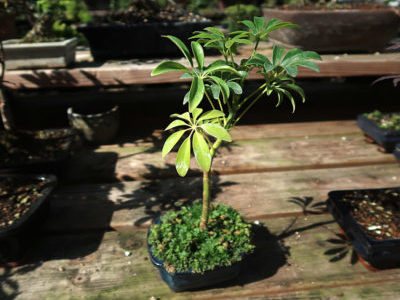

Scheffler leaf propagation
This propagation method is suitable for experienced growers. To obtain planting material, you should tear off a large leaf plate from an adult plant and place it in a growth stimulator solution. Then the workpiece must be placed in a warm place and covered with polyethylene.
After three weeks, the polyethylene layer should be gradually removed, reducing the temperature to 20 degrees. When the leaf adapts, it needs to be transplanted into a prepared pot with drainage and substrate.
Which of the breeding methods to choose, each grower will decide for himself.
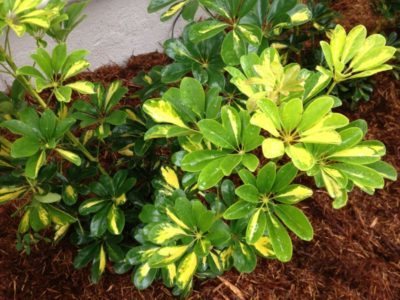

Reproduction methods
You can get a beautiful ornamental plant in several ways - both from a tree that requires correction, and simply by buying seeds of a suitable type.
Sowing
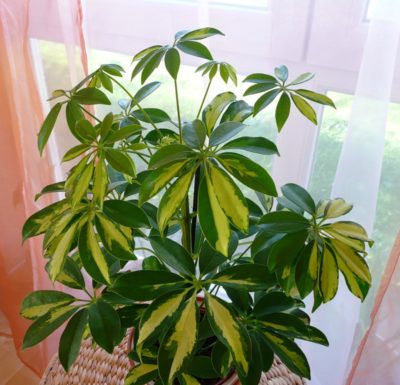

For this method, containers that are not too deep, but with sufficient area, equipped with a lid, are suitable. They will need to tightly lay soil of one of two types:
- "Palm" with the addition of vermicompost is a "heavier" soil, recommended for diving of young growth afterwards.
- "Terravita" is a "light" soil with an admixture of peat, optimal at the stage of seed germination.
The seeds themselves are somewhat reminiscent of cucumber seeds - medium in size, flat and oblong. They need to be placed in holes 3-5 cm deep. Then once again compact the soil and spill it with a growth stimulator solution. After that, the containers are loosely covered with a lid to create a greenhouse effect and are installed in a warm place. Seedlings appear within a month, sometimes 45 days.
When the seedlings acquire two or three leaves, each of them is placed in a separate pot, where they grow up to a height of 10 cm. Subsequent transplantation occurs six months later - the larger the plant, the less often the root system can be disturbed. You should not neglect feeding seedlings, complex fertilizers "Agricola" and "Good Power" are suitable for this purpose.
Benefits: minimal costs and a large number of seedlings.
disadvantages: too long process.
Air outlets
For this method, a mature plant is suitable, which for some reason has ceased to perform a decorative function - this can be rotting of the top, exposing the trunk or its curvature.
15 cm below the crown, an incision or a small scraping is carefully made on the bark, after which the prepared place is covered with nutritious soil and fixed with cling film. The soil is moistened with a solution of a growth stimulant, after which it remains to wait 2-3 weeks until the roots appear.
Benefits: fast resuscitation of an adult plant.
disadvantages: not suitable when a new Scheffler is needed.
Cuttings
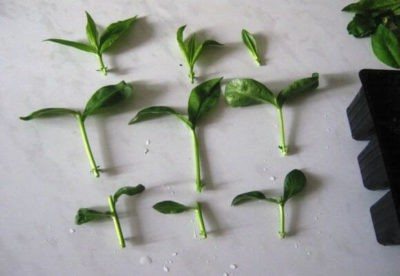

When the tree is completely in poor condition, you can use part of the trunk for rooting. The principle is the same as with the taps - the bark is scratched and the segment is placed in a nutrient solution for a couple of days, and then dropped into the nutrient soil. Even in the absence of buds, rooting will occur.
Benefits: Suitable when the plant is nearly dead.
disadvantages: a long period of time elapses from the moment of placement in the soil until the emergence of sprouts.
Rooting foliage
The versatility of this plant is that it is very tenacious, which is actively used by flower growers: they pinch off the leaves of the varieties they like, put the resulting “bouquet” in water with the addition of “Kornevin”, and then leave it in this form for a month - this time is enough for the roots to appear. Then the leaves are separated and placed in plastic cups with a lump of soil. After the entire earthen lump is filled with the root system, the plant is transplanted into a pot.
Benefits: easy to obtain visual planting material.
Minuses: new buds, depending on the variety, will have to wait from a month to a year.
Sheffler diseases and pests
The most common sheffler ailment is rot... It infects the plant if the grower floods it, keeps it cold and draughty, or overfeeds the tree. All of the above reasons lead to the fact that the plant sheds leaves, withers, black spots appear on the leaf plates..
To get rid of rot, the plant must be transplanted into a new pot and substrate, after first sorting out the root system and removing the damaged areas. To finally kill fungal spores, the roots should be kept in a weak solution of manganese for 20 minutes, after which the plant can be transplanted into the prepared soil.
- If a Sheffler leaves start to turn yellow it means that they were hit by direct sunlight and the plant was burned. You can help the tree by removing it to a slightly shaded place.
- Shefflers' leaf plates darken with a lack of light, therefore, to avoid this problem, the plant must be moved closer to the sun.
- If leaves fall, the shefflera dries, grows poorly or does not grow at all - the reason is improper care of her. Only by creating a microclimate favorable for growth and development can you eliminate all of the above problems.
In addition to diseases, the plant is susceptible to attack spider mite, thrips and scabbards... The first signs of damage by these pests is the stickiness of the leaves. By releasing its poisonous juice, the Schefflera tries to protect itself from harmful insects on its own.
To kill pests, the plant can be sprayed with a baking soda solution and the leaves can be wiped with a soapy solution. Also, the sheffler should be treated with Actellik insecticide according to the instructions on the package.
As you can see, caring for an exotic green pet is a snap. Observing all of the above recommendations, you will get a beautiful and healthy plant that will delight you with decorative leaves and fast growth, turning over time into a luxurious tree with a dense and luxurious crown.
Care problems
Shefflers often fall off leaves, the reason for this is often a lack of light, what can be done in this case?
Although the plant does not like direct rays, but, in this case, for a certain period, it must be transferred to the windowsill.
This will help restore the metabolic process and restore the color of the leaves. In winter, you can use special lamps.
When the leaves turn black, this most often indicates an excess of moisture. Having noticed these signs, the flower needs to be moved to another pot and not watered for several days, then watering once every 5-6 days.
In addition, the reason for the leaves falling off, on the contrary, may be a lack of moisture or too dry indoor air, which can also cause brown spots on the leaves.
To prevent this, you need to constantly spray the plant or place sand in the pan, it will retain moisture well, and you should also remove the flower away from heating appliances.
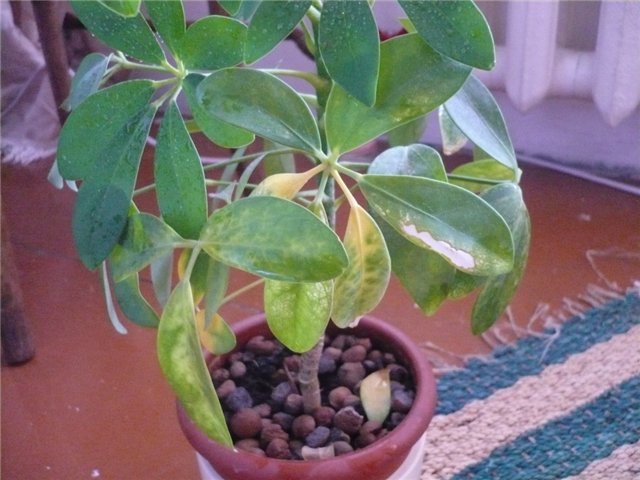

The plant is sick
Pests and diseases
Most often, the chefler is affected by spider mites, aphids and scale insects:
- Spider mite often cause yellowing and leaf fall. Noticing the cobweb, you need to remove it and treat the plant with karbofos solution.
- You can also use this solution to combat scabbardwhich leaves brown spots on the leaves.
- Aphids It is not hard to notice, it is placed in large groups and the plant weakens. The best way to destroy it is to wash the flower with water and dissolve laundry soap in it.
Schefflera is a wonderful unpretentious plant that even a beginner grower can grow, love the plant, provide it with care and it will delight you with its excellent appearance.

